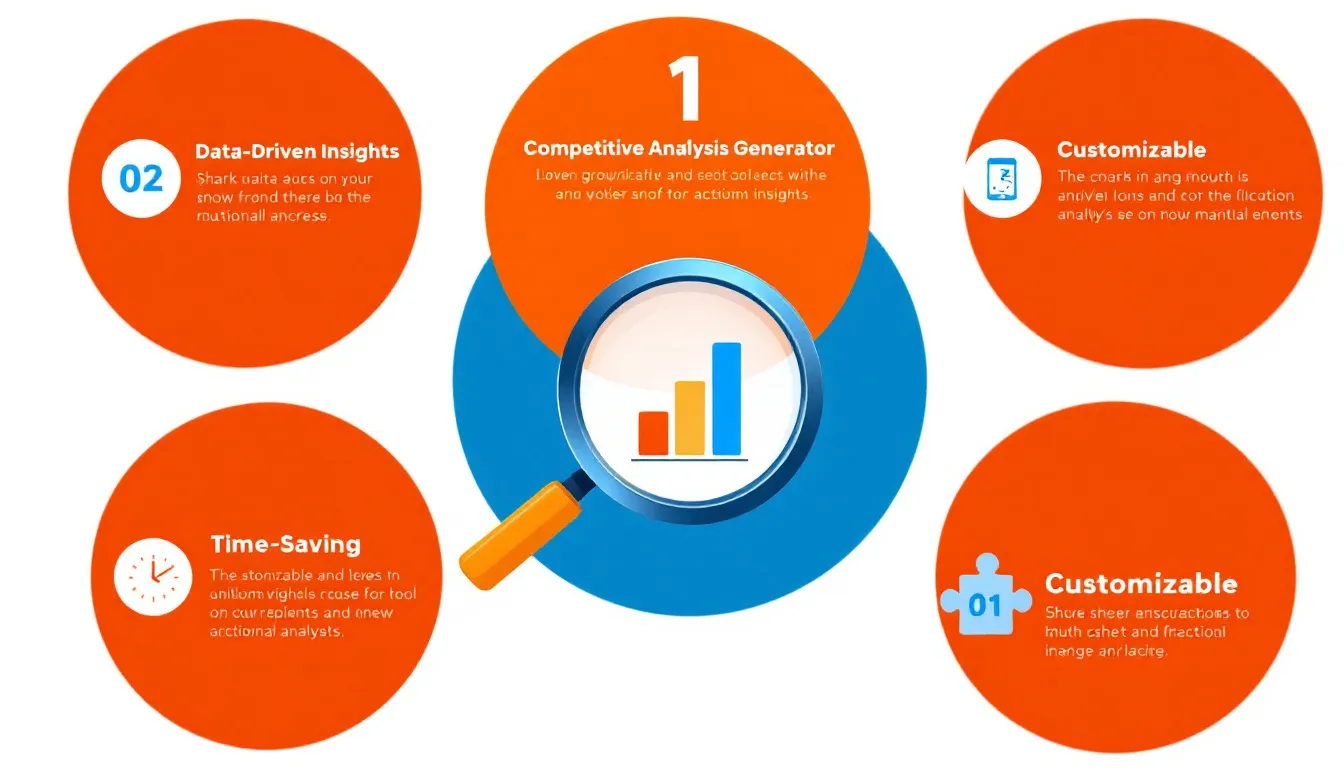Is this tool helpful?
How to Use the Competitive Analysis Tool Effectively
Follow these steps to generate a detailed competitive analysis report tailored to your business needs:
- Enter your business name: Provide the full legal name of your company. For example: BrightSky Ventures or Evergreen Digital.
- Specify your industry: Write the main market sector your business operates in. Examples include Renewable Energy or Mobile App Development.
- List your primary competitors: Enter the main competitors, separated by commas. For instance: SolarFuture Inc, GreenTech Solutions, PowerGrid Co or AppSphere, NexGen Software, CodeCraft Labs.
- Define specific focus areas for analysis (optional): Indicate particular competitive aspects to emphasize, such as Customer retention tactics, Supply chain efficiency, User experience design or Localization strategies, Pricing transparency, Product innovation.
- Submit for analysis: Click the “Generate Competitive Analysis” button to receive a comprehensive, data-driven report based on your inputs.
- Review and use the results: Read through the generated report carefully. It will provide insights into your competitive landscape and highlight strategic opportunities.
- Save or share your report: Use the handy option to copy the analysis text so you can distribute it among your team or keep it for future reference.
What Is the Competitive Analysis Tool? Purpose and Benefits
The Competitive Analysis Tool helps you evaluate your market position by examining your business alongside your key competitors. It identifies strengths, weaknesses, and opportunities by analyzing various factors such as marketing strategies, pricing, product features, and industry trends.
Purpose of the Tool
This tool simplifies the complex process of competitive research, turning raw market data into actionable intelligence. It supports your strategic planning by offering insights that improve decision-making and promote sustainable growth.
Key Benefits
- Save time: Automate the competitive research process, avoiding weeks of manual data collection.
- Comprehensive insights: Get a rounded view of your competitors’ strengths and weaknesses.
- Data-backed decisions: Use objective analysis to guide your marketing, pricing, and product development strategies.
- Spot opportunities: Discover niche markets or underserved customer segments to target.
- Reduce risks: Anticipate competitor moves and prepare accordingly.
- Benchmark performance: Compare your business against leaders to identify growth areas.
Practical Applications: How This Tool Enhances Your Strategy
1. Strategic Business Planning
Use the tool’s insights to align your goals with market realities by:
- Recognizing industry trends and future challenges
- Identifying where you outperform competitors and where you fall short
- Updating product roadmaps based on competitor innovations
- Focusing marketing efforts where competitors are weaker
2. Market Opportunity Identification
Find new growth avenues by:
- Uncovering gaps in competitor coverage
- Spotting underserved customer demographics
- Evaluating emerging market needs that match your capabilities
- Planning expansion into untapped geographic regions
3. Product and Service Enhancement
Fine-tune your offerings by learning from competitors’ strengths:
- Identifying popular features and services driving customer loyalty
- Addressing competitors’ shortcomings in your product design
- Enhancing customer experience based on competitor analysis
- Developing unique selling points that differentiate your brand
4. Optimizing Pricing Strategies
Stay competitive by understanding market pricing dynamics:
- Analyzing competitors’ pricing models and discount tactics
- Finding opportunities for premium or value-based pricing
- Adjusting prices to maximize profit without losing market share
- Reacting swiftly to pricing changes in the market
5. Improving Marketing and Sales
Leverage insights to refine your promotional approaches:
- Identifying effective marketing channels your competitors use
- Crafting compelling messaging that highlights your strengths
- Understanding how competitors attract and retain customers
- Building high-impact campaigns that directly compete with rival strategies
6. Managing Risks and Preparing for Threats
Stay alert to competitive threats by:
- Monitoring competitor innovations and new product launches
- Identifying emerging competitors and potential disruptors
- Developing contingency plans to address competitive challenges
- Maintaining your market position through proactive strategies
Addressing Your Business Challenges with Targeted Competitive Analysis
Overcoming Information Overload
Filter through vast market data quickly by:
- Combining data from diverse sources into one accessible report
- Filtering out noise to focus on relevant competitor insights
- Presenting complex information in a clear, concise format
For example, a digital marketing agency can receive a summarized report on competitors’ client acquisition funnels, popular campaign types, and budget allocations, helping them focus on the most effective tactics.
Identifying Indirect and Emerging Competitors
Expand your competitive awareness by:
- Mapping adjacent markets that may impact your business
- Spotting new entrants or substitutes before they gain traction
- Keeping track of alternative products your customers might choose
A local gym, for instance, can detect competition not only from other gyms but also from at-home fitness apps or outdoor fitness communities.
Benchmarking Your Performance
Understand where you stand by:
- Comparing key metrics like customer satisfaction, pricing, and product features
- Understanding industry best practices and standards
- Pinpointing performance gaps to target with improvement initiatives
An online retailer can benchmark delivery times, return rates, and average order values against top players in their sector.
Anticipating Market Dynamics
Prepare for changes by:
- Tracking competitor investments in research, technology, and marketing
- Analyzing historical trend data to forecast potential market moves
- Spotting shifts in regulations or consumer preferences early
A SaaS provider might monitor competitors’ feature releases and patent applications to anticipate future platform enhancements.
Supporting Go-to-Market Strategies
Increase your chances of success by:
- Evaluating competitors’ product positioning and messaging
- Identifying underserved markets or unmet customer needs
- Learning from effective marketing campaigns and distribution channels
For example, a beverage brand launching an organic line can analyze competitor pricing, shelf placement, and promotional tactics to better position its products.
Real-World Examples of Using the Competitive Analysis Tool
Tech Startup Innovating in Artificial Intelligence
A startup focusing on AI-powered customer service uses the tool to:
- Analyze the product features of leading AI platforms
- Identify underserved industries needing AI solutions
- Compare pricing and subscription models of different competitors
- Gain insights into marketing channels used by successful players
This helps the startup position its product clearly and tailor outreach to niches their competitors overlook.
Established Manufacturer Entering E-Commerce
A traditional manufacturer expanding its online presence leverages the tool to:
- Evaluate competitor websites and user experience features
- Assess digital marketing effectiveness and content strategies
- Understand shipping policies and customer service benchmarks
- Identify high-potential product categories to promote online
They use this information to build a competitive and convenient online shopping platform.
Local Restaurant Planning New Menu Items
A restaurant uses the tool to:
- Analyze competitors’ menu offerings and pricing
- Identify popular food trends in their area
- Monitor customer reviews and feedback for quality benchmarks
- Develop targeted promotions based on competitors’ marketing tactics
This analysis guides menu development and promotional efforts to attract and retain more customers.
Important Disclaimer
The calculations, results, and content provided by our tools are not guaranteed to be accurate, complete, or reliable. Users are responsible for verifying and interpreting the results. Our content and tools may contain errors, biases, or inconsistencies. Do not enter personal data, sensitive information, or personally identifiable information in our web forms or tools. Such data entry violates our terms of service and may result in unauthorized disclosure to third parties. We reserve the right to save inputs and outputs from our tools for the purposes of error debugging, bias identification, and performance improvement. External companies providing AI models used in our tools may also save and process data in accordance with their own policies. By using our tools, you consent to this data collection and processing. We reserve the right to limit the usage of our tools based on current usability factors.







